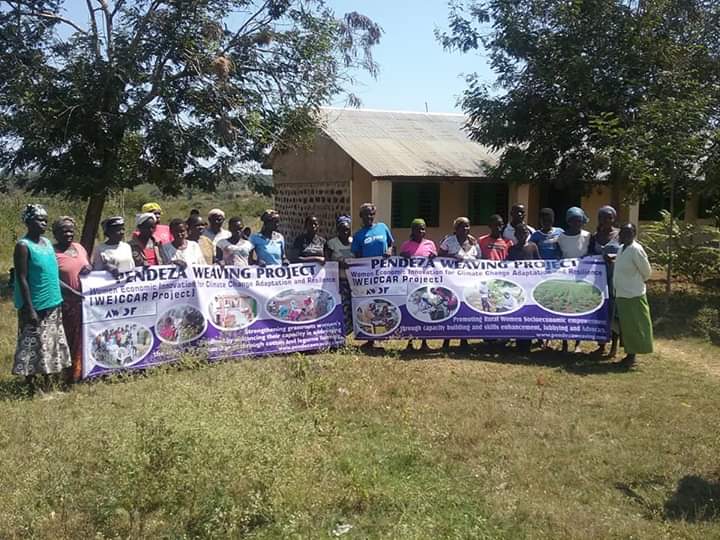
Climate-Smart Intercropping
Enhancing Sustainability and Livelihoods Through Climate-Smart Intercropping in Kitchen Gardens: A Case of Organic Cotton and Vegetable Crops for Hand Spinners
Margaret Adhiambo | Dr. David Okello. 2024.

Celebrating Success! Women of the Pendeza Weaving Project Community-Based Organization in West Sakwa in Bondo sub-county proudly pose with the WEICCAR Project banner, highlighting their journey towards empowerment through climate-smart cotton and legume farming, hand spinning, and weaving. Supported by a grant from the African Women’s Development Fund, the initiative has directly engaged 100 women and benefited 832 individuals, enhancing livelihoods and community resilience in Siaya County, Kenya.
2018
Abstract:
Climate-smart agriculture practices play a crucial role in mitigating climate change impacts while enhancing food security and livelihoods. This research article explores the implementation of climate-smart intercropping techniques in kitchen gardens, focusing on the cultivation of organic cotton and vegetable crops to meet the dual objectives of sustainable fiber production for hand spinners and food supplementation for their families. Through a comprehensive review of literature and case studies, this article highlights the environmental, economic, and social benefits of climate-smart intercropping and offers insights into its potential for promoting resilience and sustainable development in rural communities.
1. Introduction.
Climate change poses significant challenges to agricultural systems worldwide, threatening food security, livelihoods, and ecosystems. In response, climate-smart agriculture (CSA) has emerged as a holistic approach to address these challenges by integrating climate adaptation, mitigation, and resilience-building strategies (FAO, 2010). This research article focuses on the application of CSA principles in the context of kitchen gardens, where smallholder farmers, particularly hand spinners, can harness the benefits of intercropping organic cotton with vegetable crops to enhance sustainability and resilience.
2. Climate-Smart Intercropping: Concept and Principles.
Climate-smart intercropping involves the simultaneous cultivation of compatible crops with complementary growth patterns to optimize resource use efficiency, mitigate climate risks, and improve productivity (Giller et al., 2009). By diversifying cropping systems, intercropping enhances soil fertility, pest and disease management, and water retention, thereby promoting ecosystem resilience and reducing vulnerability to climate variability (Altieri, 1999). Furthermore, intercropping organic cotton with vegetable crops offers synergistic benefits, such as weed suppression, nitrogen fixation, and improved microclimate conditions, leading to higher yields and reduced environmental impacts (Hauggaard-Nielsen et al., 2001).
3. Case Study: Implementation in Kitchen Gardens.
In a rural Utonga sub-location, Sakwa West location, in the Bondo sub-county, a pilot project was initiated to promote climate-smart intercropping in kitchen gardens among hand spinners and their families. Through participatory approaches and capacity-building workshops, farmers were trained in the principles and practices of intercropping organic cotton with vegetable crops, such as tomatoes, okra, and leafy greens. By integrating organic cotton production with diversified vegetable cultivation, farmers were able to meet their fiber needs for spinning while enhancing food security and nutrition for their households.
4. Environmental Benefits.
Climate-smart intercropping enhances soil health and biodiversity conservation by reducing the need for synthetic inputs, minimizing soil erosion, and promoting natural pest control (Altieri & Nicholls, 2003). In the case of organic cotton and vegetable intercropping, the integration of leguminous cover crops improves soil fertility and nitrogen cycling, while crop diversity enhances ecosystem resilience and agroecosystem stability (Lithourgidis et al., 2011).
5. Economic and Social Impacts.
By diversifying income sources and reducing production risks, climate-smart intercropping contributes to enhanced livelihoods and economic resilience among smallholder farmers (Tittonell & Giller, 2013). The integration of organic cotton and vegetable crops not only provides hand spinners with sustainable fiber materials but also generates surplus produce for local markets, increasing household income and food security (Franzel et al., 2014). Moreover, by promoting gender-inclusive participation and knowledge sharing, climate-smart intercropping empowers women and marginalized groups within rural communities, fostering social equity and community cohesion (Dossou-Yovo et al., 2012).
6. Conclusion.
Climate-smart intercropping holds immense potential as a sustainable farming practice to enhance resilience, food security, and livelihoods in the face of climate change. The integration of organic cotton and vegetable crops in kitchen gardens offers a practical and scalable solution for smallholder farmers, such as hand spinners, to meet their fiber needs while improving nutrition and income generation. Moving forward, concerted efforts are needed to promote and mainstream climate-smart agriculture practices, ensuring their widespread adoption and impact on sustainable development goals.
References:
- Altieri, M. A. (1999). The ecological role of biodiversity in agroecosystems. Agriculture, Ecosystems & Environment, 74(1-3), 19-31.
- Altieri, M. A., & Nicholls, C. I. (2003). Biodiversity and pest management in agroecosystems (2nd ed.). CRC Press.
- FAO. (2010). Climate-smart agriculture: Policies, practices and financing for food security, adaptation and mitigation. Food and Agriculture Organization of the United Nations.
- Franzel, S., Carsan, S., Lukuyu, B., & Sinja, J. (2014). Climate-smart agriculture rapid appraisal: A toolkit for practitioners. World Agroforestry Centre (ICRAF).
- Giller, K. E., Witter, E., Corbeels, M., & Tittonell, P. (2009). Conservation agriculture and smallholder farming in Africa: The heretics’ view. Field Crops Research, 114(1), 23-34.
- Hauggaard-Nielsen, H., Ambus, P., Jensen, E. S., & Weiner, J. (2001). Interspecific competition, N use and interference with weeds in pea–barley intercropping. Field Crops Research, 70(2), 101-109.
- Lithourgidis, A. (2000). Interspecific competition, N use and interference with weeds in pea±barley intercropping
